Warning and Disclaimer
Some mushrooms
are poisonous. The simple rule to observe when picking mushrooms is:
If
in doubt,
Go without!
You do not
want to wind up in hospital due to misidentification.
The photographs
and written information on this website may not be enough for a beginner
to make confident decisions about the toxicity of a particular mushroom.
If you are
a novice, it is strongly advised that you seek out an experienced mushroomer
and obtain in-the-field guidance.
Every pictured
mushroom which is captioned as EDIBLE,
was actually eaten by the authors, however the authors and owners of this
site take no responsibility for any misidentification or improper food
handling which results in any adverse effects to the reader.

Pine plantation outside Daylesford
Mushrooming
is an activity which cannot be picked up just from a textbook. In Latvia
the skills of identifying and preparing mushrooms are handed down from
generation to generation, but in Australia, as the original Latvian immigrants
pass away, this knowledge is disappearing, and few from the second or
third generations have any desire to enter the forest and get their hands
dirty.

Further Reading
Australia
fungi illustrated
/ I R McCann - Vermont, Vic., Macdown Productions, 2003
Edible
and poisonous mushrooms of the world / Ian R Hall et al. - Portland,
Timber Press, 2003
A
field guide to Australian fungi / Bruce Fuhrer - Melbourne, Bloomings
Books, 2005
The
great encyclopedia of mushrooms - Cologne, Konemann, 1999
The
practical mushroom encyclopedia / Peter Jordan, Steven Wheeler
- London, Hermes House, 2003
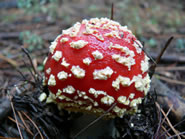
|
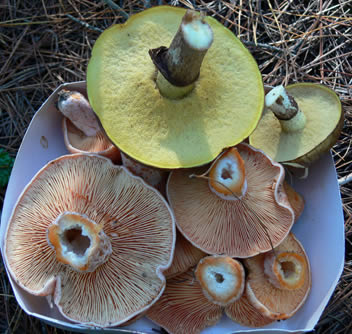
Lactarius delicious (Safron milk cap)
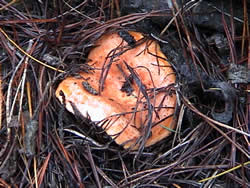 Grows
under pines and appears in autumn, particularly after heavy rain. Grows
under pines and appears in autumn, particularly after heavy rain.
This
mushroom is a favorite of Latvian immigrants, who enjoyed its wonderful
spicy nutty flavor back in Latvia.
Its bright
orange pink appearance makes it easy to recognize. It has a hollow stem,
which is loved by slugs and earwigs, so take that into account when collecting.
Bruised
areas quickly develop a green stain.

Safron milk cap (EDIBLE)
Suillus luteus. Alternative Latin name Boletus luteus (Slippery
Jack)
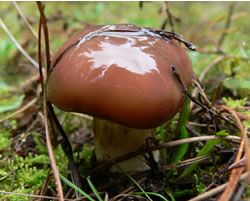
Also
grows under pines and appears in late autumn.
This
chestnut-brown mushroom has a slimy wet appearance
The cap
is convex when young (as in the specimens shown) and flattens out in maturity.
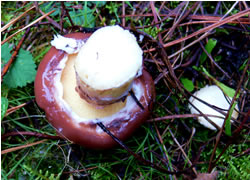
The sponge-like
pores are pale yellow when young, darkening in maturity.
This
is a very tasty mushroom. The slimy surface needs to be cleaned thoroughly
and check for bugs.
Amanita muscaria (Fly agaric)
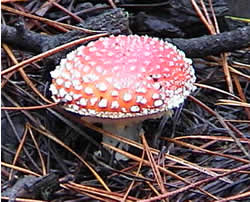 Very
beautiful but poisonous. Do not eat! Very
beautiful but poisonous. Do not eat!
Thrives under pines
and oaks.
This mushroom has
been used to kill flies. Dried pieces can be placed in a bowl of milk
and any flies that dine on them become intoxicated and either die from
the poison or fall into the milk and drown.
Fly agarics sometimes loose their spots.

More mushrooms (Identification and toxicity to follow)
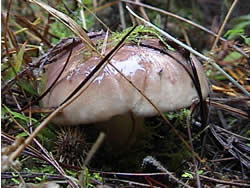

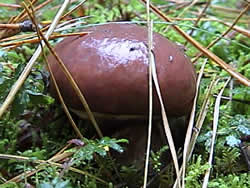
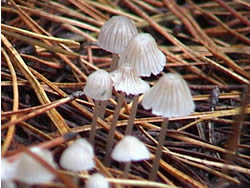

|
Preparation
of mushrooms
All
mushrooms should be prepared as soon as you return from the forest, otherwise
they will spoil or be eaten by grubs.
Spoiled
mushrooms develop strong toxins making even the most delicious mushroom
unusable; so a hostess should be very careful when purchasing mushrooms
at the market. Good mushrooms should be just picked, young, firm, dry,
free of grubs...

Mushroom market in Latvia
After
returning from the market or forest, mushrooms should be processed thus:
First remove any leaves or pine needles and discard any mushrooms infested
with grubs. Then carefully wash them twice. Mushrooms such as boletes,
field mushrooms and others which have sponge-like spore carriers similar
to boletes, can be fried, cooked and stewed straight away.
It
is recommended that other mushrooms whose spore carriers are gill-like
(for example the saffron milk cap) are boiled in water for about five
minutes. Only after such initial cooking can this group of mushrooms be
fried, sauteed or prepared in other ways. It should be stated that mushrooms
must not be heated for too long (no longer than 10 minutes) for otherwise
they will become firmer and harder to chew. For some mushrooms it is recommended
that the hostess remove the skin, for others the spore carrier. The skin
can be removed from Slippery Jacks so that they are no longer slimy. The
spore carrier is only removed if a mushroom is rather large or old.
Regarding
mushroom stems. They are used with the cap if the mushroom is young, or
separately in mushroom broth if they are hard and old.
Recipes
Fried
mushrooms
(larger boletes or cep and field mushrooms)
Mushrooms
- 600-800g
Butter - 50g
Eggs - 2
Bread crumbs - 100g
Salt & pepper - to taste
For
large mushrooms cut the cap from the stalk and cut the stalk into finger
thick slices. Boil for 5 -10 minutes in salt water. Dry the mushrooms
with a clean cloth then sprinkle with salt and pepper. Dip the mushrooms
in partially whipped eggs, then roll in bread crumbs, dip in the egg again
and roll once more in bread crumbs. Place in heated butter on a pan and
cook both sides until golden brown.
Finally
place the fried mushrooms on a baking dish, decorate with greens and serve
with dry potatoes, melted butter or sour cream sauce.
Sour
cream sauce
Fat
or butter - 30-40g
Plain flour - 15-20g
Liquid - as required
Salt - to taste
Sour cream - 1 desert spoon
Combine
the melted fat or butter with the flour on a pan and stir until golden
brown. While stirring slowly add liquid (broth or water) to the browned
flour until fully mixed. If necessary strain the sauce then add salt and
sour cream.

Mushroom
sauce
Bacon - 100g
Mushrooms - 200g
Plain flour - 10-20g
Liquid - as required
Salt, onion - to taste
Various
mushrooms can be used in the sauce - saffron milk caps, boletes, chantarelles,
etc. The mushrooms, bacon and onion are chopped into small cubes and fried,
mixing in the flour. Continue frying, then add liquid and cook. Finally
add in the sour cream.
Mushroom
sauce can be served with meat or vegetarian dishes.
(Preparation
and Recipes translated from the Latvian classic text:
Latvian and modern kitchen : advice for hostesses on correct food
preparation / H Stabulnieks-Birzina , A Švagers - Riga,
Grinbergs, 1939)
|

